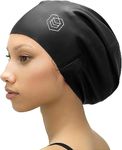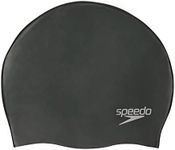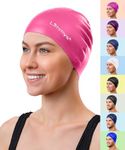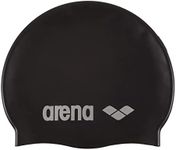Buying Guide for the Best Womens Swim Caps
Choosing the right swim cap can enhance your swimming experience by providing comfort, reducing drag, and protecting your hair from chlorine and saltwater. When selecting a swim cap, consider the material, fit, and design that best suits your swimming needs and personal preferences. Whether you're swimming for leisure, training, or competition, the right swim cap can make a significant difference in your performance and enjoyment in the water.MaterialSwim caps are typically made from silicone, latex, or lycra. Silicone caps are durable, hypoallergenic, and provide a snug fit, making them ideal for competitive swimmers. Latex caps are thinner and more affordable, but they can cause allergies in some people and are less durable. Lycra caps are comfortable and easy to put on, but they don't provide as much water resistance. Consider your swimming frequency and any material sensitivities when choosing the right material for you.
FitThe fit of a swim cap is crucial for comfort and performance. A well-fitting cap should be snug but not too tight, covering your hair completely without causing discomfort. Caps come in various sizes, so it's important to try them on if possible or check size guides. If you have long or thick hair, look for caps designed to accommodate more hair volume. The right fit will ensure the cap stays in place during your swim and provides the best protection for your hair.
DesignSwim caps come in a variety of designs, from plain colors to vibrant patterns. While design is often a matter of personal preference, it can also serve practical purposes. Brightly colored caps can increase visibility in open water, enhancing safety. Some designs may also feature textured surfaces to reduce drag. Consider where you'll be swimming and whether visibility or reduced drag is important to you when selecting a design.
Ease of UseEase of use refers to how easy it is to put on and take off the swim cap. Silicone caps can be a bit more challenging to put on due to their snug fit, but they offer excellent water resistance. Lycra caps are easier to handle and put on, making them a good choice for casual swimmers or those who prioritize convenience. Consider how often you'll be using the cap and how important ease of use is to you when making your choice.
DurabilityDurability is an important factor, especially if you swim frequently. Silicone caps are known for their durability and can withstand regular use without tearing. Latex caps, while less expensive, are more prone to tearing and may need to be replaced more often. Lycra caps are durable in terms of fabric but may lose elasticity over time. Think about how often you swim and how long you want your cap to last when considering durability.















